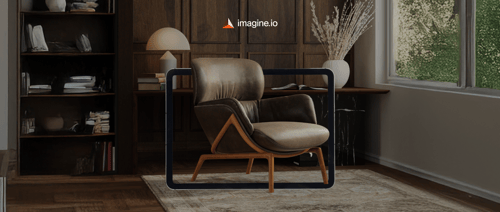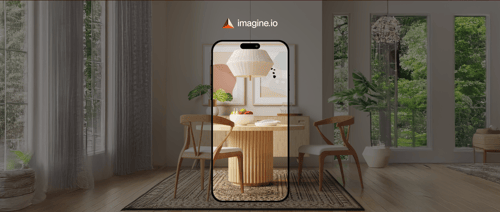Great product photos will transform a visitor into a purchaser. For eCommerce businesses, high-quality product photography is the key to sales: 93% of consumers consider visual appearance to be the number one deciding factor in a purchasing decision. A product page with beautiful imagery is 362% more likely to be viewed by potential buyers and can increase sales by more than 50%. And with so many choices out there, sometimes the decision to buy comes down to who has the best photos.
eCommerce websites like Amazon and Wayfair dominate retail sales, and with sites like Shopify, Etsy, and eBay, any business can quickly build an online presence but you must be willing to create product imagery that engages and captures your audience. Those who have ever tried traditional product photography know just how time-consuming and expensive it can be. That's why when you're considering product photography for your eCommerce business there's a better way to create content using 3D.
-2.jpeg?width=4000&name=Square%20Feathers_RS-o1%20(1)-2.jpeg)
Get the latest updates straight to your inbox.
By clicking sign up you'll receive occasional emails from imagine.io. You always have the choice to unsubscribe within every email you receive.
What is Product Photography?
Product photography, as it is sometimes called, is what the term describes: photographs taken and used on eCommerce websites and social media to drive your products and service sales.
Commercial photographers have unique challenges and opportunities that are unique to their profession. Find out how to improve the appearance of an artwork or photograph. You don't need fancy equipment or expensive training to capture compelling product photos… all you need is some inspiration and a few tricks of the trade. If you want to take highly engaging product photos.
Types of Product Photography
Photography is not a perfect tool. Similarly to e-commerce websites you may offer various products and services, product images also come in varying styles.
Some of these are intended for everyday use, but some are purely personal and are used only for specific applications. You should also know the difference between different product photography types to get the best results. This lists six common types of photographic products that are commonly seen.
Packaging shots
For furniture and home furnishing companies this may not seem too important, but we've all seen Casper and Endy ads, which clearly display their packaging and simplicity.
So, in some cases, packaging is still an important piece of the puzzle when selling large products online. If a product looks great and the presentation isn't good enough, your customers might notice it too. Convenience, quality and presentation are all important factors for a consumer when buying via eCommerce.
Can they fit the package through the door? Will it break in-transit? Is it out-of-the-box or does it require assembly? Consumers are paying for so much more than just a product, they are purchasing an experience, and if that experience doesn't delight them, they'll move on.
Scale shots
A common problem when buying online is the inability to know the actual size. Despite a description explaining the product dimensions, product photos are sometimes deceptive.
That's why scale pictures are helpful for getting the customer to know how large your products are by comparing them to other everyday items such as those shown in the picture below.
You can make a better judgement on the size of the rug, next to the foot stools in the image. This enables you to sell your products and services with greater buyer confidence and improve online customer satisfaction.
Lifestyle shots
Lifestyle shots, also depicted here, allow consumers to visualize your products in home. It can also provide you with photos showing your product. Lifestyle shots also tell your story and show how to use your products in everyday imagery.
Lifestyle scenes compliment your individual product pictures and are ideal for social networks, email, ads and other visual channels because they are attractive and makes your product feel more personal.
Traditional lifestyle shots can be time consuming and costly. They involve booking studio time, creating multiple sets, getting the perfect lighting, and it goes on and on.
That's why the imagine.io 3D content studio is a great alternative for studio photography. It gives you thousands of templates and props to choose from, with lighting customizations, and 360 angles, without any design or photography skill required.

Silhouettes
Silhouettes or individual shots are generally the earliest kind of product photo, and only has one object inside it. These are often included in product catalogues, banners or on eCommerce pages as they showcase the facets, and movement of a product without any background noise.
Many consumers rely on these types of shots to determine whether a product has the right style and function for their space. In these shots, a product is place on a white background for a clean, simple look and keeps focus on the product(s).
Group shots
Typically the group shot showcases several products together for product kits and collections and shows the product variety, as well as giving customers an overview.
These are ideal for Instagram posts and ads because they offer the consumers an overview of your offering in its entirety and not just one item. It can be difficult to know how the best layout of a group shot using traditional product photography, which is why a 3D content studio offers the ability to seamlessly adjust shots quickly and efficiently. No one *really* wants to move around recliners all day to get the perfect shot do they?
Detail shots
These shots are ideal for textiles and accessories which require close-up detailed imagery to highlight the patterns, textures, and features of specific products that a traditional image cannot capture or show. These types of photographic activities often require specialized lighting and camera settings, e.g. macro lenses. They also require a specialized photography skills that may go above and beyond the average photographer. 3D content eliminates the need for specific lighting, specialized lenses, or skilled photographers, by allowing you to zoom in and out on your models to capture every little detail. If you need multiple textile shots you can easily have them scanned for 3D application, allowing you to reuse and repurpose your textiles over and over again.
Product Photography Tips for Amazon, Shopify & Wayfair and More
Is there a reason why you select one product over the other on Amazon? It's probably not by chance, and most often comes down to the content. And you know it or not, oftentimes brands are using 3D imagery to achieve the ideal shot.
It isn't easy to create high-definition images, and even the most skilled photographer will work tirelessly to achieve a professional looking product photo. 3D content enables users to achieve this without training or eduction, but learning the basics of lighting, styling, and composition, will help anyone master the art of 3D styling in no time.
If you want to achieve professional looking product shots on Amazon, Etsy, and Wayfair, you should consider having the following imagery:
When in doubt, stick to a plain white background

Commonly used for product listings in online stores like Amazon or Etsy, these photos usually have a simple white background to limit distractions. Product-only images capture the details of the subject, such as size, silhouette, and color. These specifics help consumers find exactly what they're looking for when shopping online.
It's important that you keep everything in plain sight so that the product is not buried in the shot. White creates a bright and clear background and highlights all the dimensions in your product.
This is not as simple as setting up a product in front of white drywall. Cameras can pick up little blemishes on a white wall that you wouldn't notice, which is why 3D content makes this process simple and flawless.
Display the details
Consumers need visual help in absorbing information from your product. Think of these as visual bullet points. Take time to capture every detail of the product to help anyone see exactly what the product offers.
Detailed images give online shoppers a closer look at specific product features such as patterns, finishes, fabrics and more. Give consumers the confidence to know that what they see is what they get, especially for large purchases like furniture and home furnishings.
Follow the product photography specifications
Amazon offers enormous opportunities for e-commerce marketers. You must also comply with platform-specific requirements when taking product photography for your product photography.
Not sure what these requirements are? Our creative companions know exactly what you need to get your photos optimized and ready to sell on Amazon and Wayfair.
Put your product in context
Your prospective customers need your products. But how will they know if you don't show them? By incorporating lifestyle imagery in your eCommerce content you make your story clear to potential buyers. When people with limited disposable income buy something, they should have a good idea that the item improves their daily lives.
You have no way of seeing its versatility or function, or how much you will use a product if it is completely out of context. Videos are great for amplifying your product photography with imagery that helps consumers visualize exactly what it does. imagine.io makes it easy to capture and record 3D product videos without the need for professional videographers.
Use simple props
Don't be too ambitious about the prop you use for product photography! Ensure each product photograph shows the product. The props may help improve the picture for viewers. In the following image we can see some simple props being used to complete this lifestyle shot: a vase with flowers, a book, a drink, a table, a mirror, a lamp. These items help to style the image and bring everything together.
They do not detract, and instead, enhance the products on display. imagine.io has a collection of thousands of props added daily to its library to ensure you can find and leverage the right props for your needs.
Multiple angles
Just as close-up shots and details are important, so are product angles. By taking multiple shots of your product from different angles consumers get a better sense of its style, its function, and all facets of the product.
We all spend time scrolling through multiple angles of a couch before we purchase it for our living room. We want to be able to visualize whether it works with our existing layout, furnishings, and more. imagine.io provides users with 360 spins and the ability to take shots from every angle for greater context to convert more buyers.

The more product photos, the better!
It goes without saying that when it comes to eCommerce product photography, more is better. You consumers ability to fully grasp every detail about the product will inevitability lead to consumer confidence, higher conversions, and lower returns. Just as your customers look, hold, use, and even test merchandise in a store, your should have a variety of 3D images to simulate this very experience. By taking shots from different angles, close up shots, video, and more, you can easily achieve a collection of imagery that engages visitors and coverts them into buyers.
Finally, set the right lighting
Without proper light, neither your product nor your background is going to appear how it does to you in person. A white background without light doesn't appear white in a photo, it appears grey, however, it's possible to overcome this with 3D imagery. You can still choose natural light or artificial light but you have that much more control over how it looks and feels in a photo.
Natural lighting vs. Artificial light
There are still a few things to consider when determining whether to use natural light or artificial light in your 3D imagery. You should think about which option is best for your product and the environment.
If the product is meant to be used outside like patio furniture or you're trying to emphasize the product's surroundings, rather than specific attributes of the product it's best to use natural light. Here's an example of a shot using natural light:
It's also referred to as "hard light" because it produces a smaller but more focused light surface. As you can see the light source appears to be coming only from the sky outside and no other additional light source, which emphasizes the wood grain on the patio furniture, and also how this product would look when actually being used.
Natural light works well for indoor imagery as well, especially with bedding or living room furnishings that are typically near a natural light source such as a window.
On the other hand, if your product is primarily used indoors such as accessories like details artwork, then artificial lighting may be preferable. Luckily knowing a few basics and building a simple studio setup can help you get over your intimidation of light.
imagine.io's 3D content studio simplifies the complex and time consuming process of trying to find the perfect light for your products, and if you aren't sure whether to use natural or artificial light sources, you can easily change the light without going anywhere!
What About Post Production for Product Photography?
Typically, product photography requires special equipment, software, and skills, and is also hugely time-consuming during the shoot and during post production as well. It is an expectation to have 360-degree product images, lifestyle images, silhouettes, and more. This leads to an extraordinarily expensive method of creating content –– one day of shooting can cost $5000, and this price does not include post production edits, detail or close up detail shots. For the amount of time, money, and effort traditional product photography takes, it's possible to achieve stunning professional imagery with a reasonable budget and in less time!
Plus, you can skip post-production, and ensure you create the perfect shot every time when you create imagery using the imagine.io 3D content studio.





.png?width=500&name=How%20to%20Add%20a%203D%20Product%20Configurator%20to%20Your%20WordPress%20Website%20(Complete%20B2B%20Guide).png)
















%20(1).png?width=500&name=Why%20Exploded%20Mattress%20Views%20Matter%20(And%20How%20to%20Generate%20Them)%20(1).png)
.png?width=500&name=Best%20Shopify%20Product%20Configurator_%20How%20to%20Choose%20the%20Right%20One%20(2).png)
.png?width=500&name=Why%20Exploded%20Mattress%20Views%20Matter%20(And%20How%20to%20Generate%20Them).png)



.png?width=500&name=Best%20Shopify%20Product%20Configurator_%20How%20to%20Choose%20the%20Right%20One%20(1).png)







.png?width=500&name=How%203D%20Rendering%20Can%20Make%20or%20Break%20Your%20Industrial%20Design%20Pitch%20(1).png)








%20with%20Digital%20Twins%20and%203D%20Visualization.png?width=500&name=Optimizing%20Your%20Digital%20Asset%20Management%20(DAM)%20with%20Digital%20Twins%20and%203D%20Visualization.png)




.png?width=500&name=Styling%20Home%20Decor%20for%202025_%20From%20Global%20Influences%20to%20Playful%20Personalization%20(1).png)
